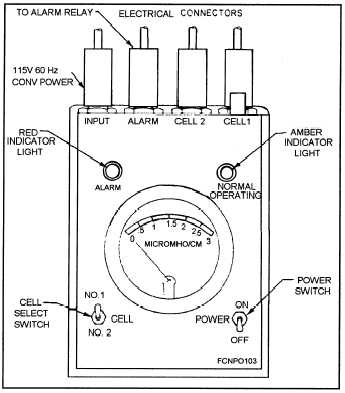Oxygen Removal Cartridge: The oxygen
removal cartridge is composed of anion (negative
charge) resins that remove oxygen from the water by
ion exchange of sulfite ions to sulfate ions. By con-
ducting a standard oxygen test (if the cooling system
has an oxygen analyzer installed), you can test the
quality of the outlet water from the demineralizer for
oxygen content so that you will know when to replace
an oxygen cartridge. When the oxygen cartridge is
near exhaustion, it will have a urine odor, which is
given off by the sulfate.
Mixed-Bed Cartridge: The mixed-bed car-
tridge is filled with cation (positive charge) and anion
(negative charge) resins, which remove solids, dis-
solved metals, and carbon dioxide. The charged resins
exchange ions with the contaminates, thereby remov-
ing them and leaving pure deionized coolant. Replace
the mixed-bed cartridge when the purity meter indi-
cates a low outlet purity.
Two conductivity cells monitor the coolant
through the demineralizer. The first cell measures the
purity of the coolant as it enters the demineralizer.
The second cell measures the purity of the coolant as
it leaves the demineralizer A conductivity cell con-
sists of two electrodes immersed in the coolant flow
path. The electrodes measure the conductivity of the
coolant, which varies with the amount of ionized salts
dissolved in it. If the impurity content increases in the
coolant, the purity meter indicates higher conduct-
ance.
On some purity meters, the purity of the coolant is
displayed as resistivity. In this typeof meter, an in-
crease in the impurity of the coolant causes the meter
to indicate a low resistivity. Conductance is the
reciprocal of resistance, and is measured in siemens.
Figure 2-21 shows a purity meter.
Figure 2-21.—Purity meter.
Resistivity is measured in megohms/cm. You can
convert from conductivity to resistivity by taking the
reciprocal of conductivity. Similarly, the reciprocal of
resistivity is equal to the conductivity. A comparison
of both ways of measuring the purity of the coolant
is shown in table 2-1.
Table 2-1.—Distilled-Water Resistivity Versus Conductivity Data
2-22



